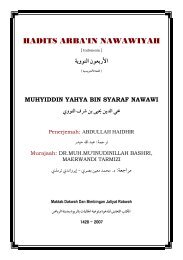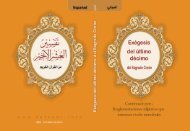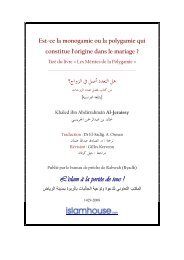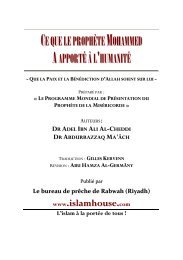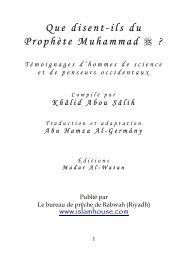is allah (sw) one or three? - Islam Center
is allah (sw) one or three? - Islam Center
is allah (sw) one or three? - Islam Center
You also want an ePaper? Increase the reach of your titles
YUMPU automatically turns print PDFs into web optimized ePapers that Google loves.
(٥١)IS ALLAH (S.W) ONE OR THREE?To understand the passage clearly, the prominent scholar Deedatbrings us back to the Greek <strong>or</strong>iginal codex.The actual translation of that passage <strong>is</strong>, “in the beginning was thew<strong>or</strong>d, and the w<strong>or</strong>d was with God”. The Greek translation uses thew<strong>or</strong>d (hotheos), which translates as “God”, in Engl<strong>is</strong>h with the capital‘G’ referring to the real divinity.The passage continues saying, “the w<strong>or</strong>d was god”, here, the Greek<strong>or</strong>iginal uses the w<strong>or</strong>d (tontheos). The Engl<strong>is</strong>h translation should usethe w<strong>or</strong>d (god) with a small letter, to indicate the figurative divinity asthe Bible uses in many places; I will l<strong>is</strong>t a few examples below.In the Book of Exodus, we read, “I have made you like God toPharaoh” (Exodus 7/1).When he was talking about the devil that Paul called him the “god ofage”, who blinded the mind of the unbelievers (see, C<strong>or</strong>.2 4:4). TheGreek <strong>or</strong>iginal used the w<strong>or</strong>d (tenthoes) in Paul’s Ep<strong>is</strong>tle, and ittranslated to (god) in Engl<strong>is</strong>h, using the indefinite article (a).The Holy Bible Engl<strong>is</strong>h translat<strong>or</strong>s changed the Greek passage ofJohn’s Gospel, using the w<strong>or</strong>d “God” which refers to the real divinity,instead of (god) which refers to the figurative meaning, which makesthe confusion in th<strong>is</strong> passage, and that - without doubt – <strong>is</strong> a kind offabrication. 1Some translations realized th<strong>is</strong> m<strong>is</strong>translation and used the c<strong>or</strong>rectf<strong>or</strong>m of the w<strong>or</strong>d; <strong>one</strong> of them <strong>is</strong> the New W<strong>or</strong>ld Translation, in itsvarious universal translations, it says, (and the w<strong>or</strong>d was a god).In addition, I have designated a special appendix to show thed<strong>is</strong>t<strong>or</strong>tion in many different copies in reading th<strong>is</strong> w<strong>or</strong>d. Some of whatI menti<strong>one</strong>d <strong>is</strong>, “In John’s sentence, whether the W<strong>or</strong>d <strong>or</strong> Logos was(god) <strong>or</strong> (divine) <strong>or</strong> (as god), does not mean that God was with God;it <strong>is</strong> only a character<strong>is</strong>tic of the W<strong>or</strong>d <strong>or</strong> Logos, and it does notdetermine its identity as God Himself”.I quoted from Phillip H<strong>or</strong>ner, a writer in the Holy Bible LiteratureMagazine, h<strong>is</strong> saying in (volume 92/87), “I think the descriptionindication in (John 1:1) <strong>is</strong> so obvious, we cannot consider the namedefinite”1 - Two debates in Stockholm, Ahmad Deedat, pp 135-137. Chr<strong>is</strong>t in <strong>Islam</strong>, AhmadDeedat, pp 84-87




